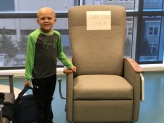Modeling the Multi-hit Pathogenesis of t(12;21) Associated Pediatric ALL by CRISPR/Cas-mediated Genome Engineering
Background
About one in 2000 children in the US are diagnosed with preB-cell acute lymphoblastic leukemia (ALL). With current therapy, not all children can be cured, and too many are affected by long-term side effects of their therapy. The options for children who do suffer relapses are insufficient. Development of targeted treatment strategies that are less toxic and more efficient requires a precise understanding of the molecular mechanisms that cause the disease. In a large fraction of childhood leukemia patients, a chromosome abnormality (called t(12;21) translocation) is already formed in embryonic blood cells, but the disease does not present itself clinically until children are 3-4 years old.
It is poorly understood what happens in the silent period that precedes the illness. However, it has emerged that the initial translocation cooperates with multiple additional gene abnormalities that accumulate in the affected cells. Large-scale studies of leukemia cells have identified the spectrum of genes that are commonly affected by later "hits." However, no experimental model system exists that recapitulates the human disease because a large number of concomitant abnormalities are required to render normal cells fully leukemic.
Project Goal
Recently, there have been breakthroughs in the techniques for altering genes in living cells that allow for the first time to efficiently introduce multiple, simultaneous mutations at once. Here, we propose to utilize the novel technology to recreate the multi-step process that leads to childhood leukemia in mice. The model will provide a faithful system to understand the leukemia, identify its vulnerabilities and test new therapies.

